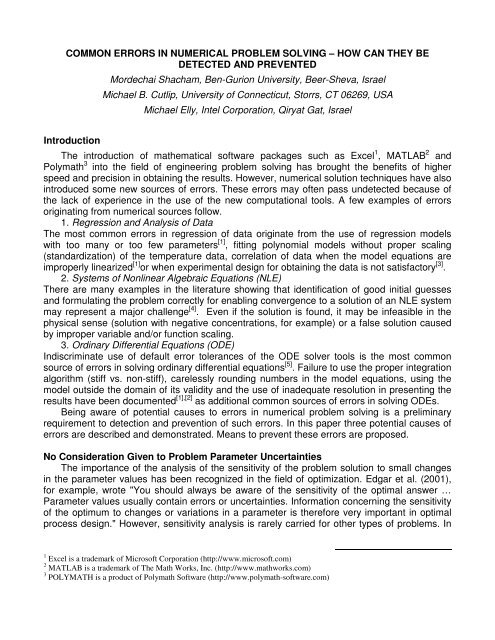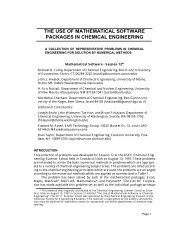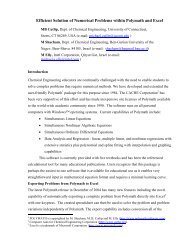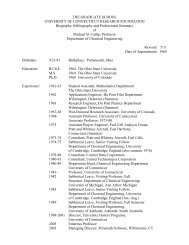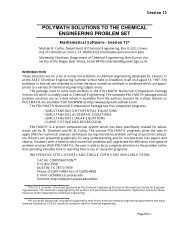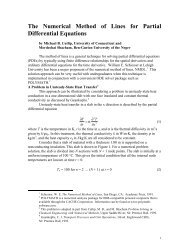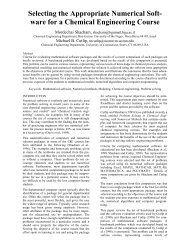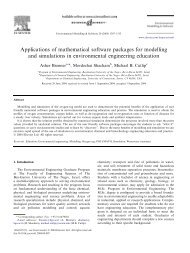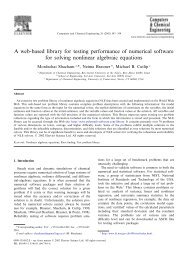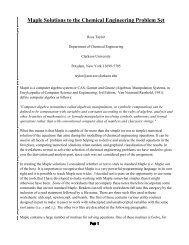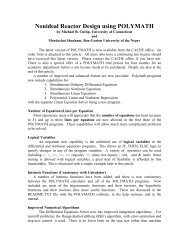COMMON ERRORS IN NUMERICAL PROBLEM SOLVING – HOW ...
COMMON ERRORS IN NUMERICAL PROBLEM SOLVING – HOW ...
COMMON ERRORS IN NUMERICAL PROBLEM SOLVING – HOW ...
Create successful ePaper yourself
Turn your PDF publications into a flip-book with our unique Google optimized e-Paper software.
<strong>COMMON</strong> <strong>ERRORS</strong> <strong>IN</strong> <strong>NUMERICAL</strong> <strong>PROBLEM</strong> SOLV<strong>IN</strong>G <strong>–</strong> <strong>HOW</strong> CAN THEY BE<br />
DETECTED AND PREVENTED<br />
Introduction<br />
Mordechai Shacham, Ben-Gurion University, Beer-Sheva, Israel<br />
Michael B. Cutlip, University of Connecticut, Storrs, CT 06269, USA<br />
Michael Elly, Intel Corporation, Qiryat Gat, Israel<br />
The introduction of mathematical software packages such as Excel 1 , MATLAB 2 and<br />
Polymath 3 into the field of engineering problem solving has brought the benefits of higher<br />
speed and precision in obtaining the results. However, numerical solution techniques have also<br />
introduced some new sources of errors. These errors may often pass undetected because of<br />
the lack of experience in the use of the new computational tools. A few examples of errors<br />
originating from numerical sources follow.<br />
1. Regression and Analysis of Data<br />
The most common errors in regression of data originate from the use of regression models<br />
with too many or too few parameters [1] , fitting polynomial models without proper scaling<br />
(standardization) of the temperature data, correlation of data when the model equations are<br />
improperly linearized [1] or when experimental design for obtaining the data is not satisfactory [3] .<br />
2. Systems of Nonlinear Algebraic Equations (NLE)<br />
There are many examples in the literature showing that identification of good initial guesses<br />
and formulating the problem correctly for enabling convergence to a solution of an NLE system<br />
may represent a major challenge [4] . Even if the solution is found, it may be infeasible in the<br />
physical sense (solution with negative concentrations, for example) or a false solution caused<br />
by improper variable and/or function scaling.<br />
3. Ordinary Differential Equations (ODE)<br />
Indiscriminate use of default error tolerances of the ODE solver tools is the most common<br />
source of errors in solving ordinary differential equations [5] . Failure to use the proper integration<br />
algorithm (stiff vs. non-stiff), carelessly rounding numbers in the model equations, using the<br />
model outside the domain of its validity and the use of inadequate resolution in presenting the<br />
results have been documented [1],[2] as additional common sources of errors in solving ODEs.<br />
Being aware of potential causes to errors in numerical problem solving is a preliminary<br />
requirement to detection and prevention of such errors. In this paper three potential causes of<br />
errors are described and demonstrated. Means to prevent these errors are proposed.<br />
No Consideration Given to Problem Parameter Uncertainties<br />
The importance of the analysis of the sensitivity of the problem solution to small changes<br />
in the parameter values has been recognized in the field of optimization. Edgar et al. (2001),<br />
for example, wrote "You should always be aware of the sensitivity of the optimal answer …<br />
Parameter values usually contain errors or uncertainties. Information concerning the sensitivity<br />
of the optimum to changes or variations in a parameter is therefore very important in optimal<br />
process design." However, sensitivity analysis is rarely carried for other types of problems. In<br />
1 Excel is a trademark of Microsoft Corporation (http://www.microsoft.com)<br />
2 MATLAB is a trademark of The Math Works, Inc. (http://www.mathworks.com)<br />
3 POLYMATH is a product of Polymath Software (http://www.polymath-software.com)
this section, the importance of the sensitivity analysis in solving systems of nonlinear algebraic<br />
equations will be demonstrated.<br />
The example considered was originally published by Froment and Bishoff (1990), and its<br />
solution using Mathcad was presented by Parulekar (2006). The reaction considered is the<br />
catalytic hydrogenation of olefins (component A) in an isothermal CSTR. Differential mass<br />
balance on component A yields<br />
dC<br />
dt<br />
A<br />
C<br />
=<br />
A0<br />
− C<br />
τ<br />
A<br />
− r<br />
A<br />
where CA0 is the inlet concentration of A (mol/L), τ = V / v0<br />
is the space time (s), V is the reactor<br />
volume (L), v0 is the inlet flow rate (L/s) and rA is the reaction rate per unit reactor volume<br />
(mol/L·s):<br />
r<br />
A<br />
( ) 2<br />
C A<br />
= (2)<br />
1− C A<br />
The concentration of A at steady-state is sought for the operating conditions: CA0 = 13<br />
mol/L; V = 10 L; and v0 = 0.2 L/s. Finding the steady-state solution requires solving the<br />
nonlinear algebraic equation f(CA) = 0 where<br />
C − C<br />
( rA<br />
(3)<br />
τ<br />
A0<br />
A<br />
f C A ) = −<br />
In Figure 1, f(CA) is plotted versus CA for the region 0 ≤ CA ≤ 10. Observe that in this region<br />
there are three real solutions. The solutions as obtained by the Polymath 6.1 software package<br />
are: CA * = [0.7515358, 2.130933, and 8.117532]. Polymath displays the results showing 7<br />
significant digits. Mathcad displays the same results with 20 significant digits (Parulecar, 2006).<br />
The discrepancy between the number of significant digits in the CSTR parameters (one or two)<br />
and the number of those digits reported in the solution (up to twenty) cannot be missed. The<br />
determination of the number of significant digits to be shown in the documentation of the<br />
problem solution should be based, in this particular case, on the uncertainty associated with<br />
the parameter values.<br />
In Table 1, the values of CA at the solution are presented for various levels of uncertainty in<br />
the flow rate v0. Assuming an uncertainty of 10 -4 L/s (thus flow rate of 0.2001 L/s instead of 0.2<br />
L/s) yields solution values which match the base solution only in the first two digits. For<br />
uncertainty of 10 -3 L/s there is only one correct digit in the first two roots and two correct digits<br />
in the largest root. For an uncertainty of 0.01 L/s there is not even a single correct digit in the<br />
first two roots and one in the largest root. Thus, any realistic estimate for the uncertainty in the<br />
value of the flow rate leads to the conclusion that the solutions for CA should be rounded up to<br />
two significant digits as all the additional digits are uncertain. It should be emphasized that this<br />
analysis applies only to physical quantities which obtained as the final results of the<br />
computation. There are other cases where rounding the numbers may lead to significant<br />
errors. This will be demonstrated in one of the following examples.<br />
As the value of the flow rate is specified by one significant digit, only one possible<br />
assumption regarding the uncertainty could be that the flow rate was measured (or controlled)<br />
(1)
with such an accuracy, thus its value could vary in the range of 0.15 L/s ≤ v0 ≤ 0.24 L/s. In the<br />
last two rows of Table 1 the solutions for the two extreme values of v0 are shown. For v0 = 0.24<br />
L/s there is only one real root at CA = 9.36922 mol/L while for v0 = 0.15 L/s there is one real<br />
root at CA = 0.3419 mol/L. Thus, in these cases there is only one root instead of the three roots<br />
for the base value of v0 = 0.2 L/s, and the roots are completely different.<br />
Use of Inappropriate Statistics and Graphical Representations in Analysis of Regression<br />
Models<br />
The use of inappropriate statistics and graphical representation may often lead to the<br />
acceptance unsatisfactory regression models. This phenomenon will be demonstrated by fitting<br />
the Clausius-Clapeyron equation to vapor pressure (PV) data of ethane. The vapor pressure<br />
data, containing N = 107 points, are available [8] in the temperature range of T = 92 K (PV = 1.7<br />
Pa) through T = 304 K (PV = 4.738*10 6 Pa). This range covers essentially the liquid phase<br />
region between the triple point temperature (= 90.352 K) and the critical temperature (TC =<br />
305.32 K) of ethane. The Clausius-Clapeyron equation is considered inappropriate for<br />
modeling vapor pressure for such a wide range of temperatures and we want to examine what<br />
kind of statistics and/or graphical representation can reveal this inappropriateness.<br />
The Clausius-Clapeyron equation is given by<br />
B<br />
ln = A +<br />
(4)<br />
( )<br />
P V<br />
T<br />
where A and B are coefficients calculated by regression of experimental data.<br />
In Figure 2 ln(PV)exp is plotted versus 1/T. The straight line fitted to the data is also shown. The<br />
linear equation obtained is<br />
yˆ = 21.<br />
816 + 1919.<br />
5x<br />
(5)<br />
where x = 1/<br />
T and y PV<br />
calc ) ln( ˆ = . The correlation coefficient R2 is defined<br />
N<br />
∑<br />
2 i=<br />
1<br />
=<br />
N<br />
∑<br />
i=<br />
1<br />
( yˆ<br />
− y)<br />
i<br />
2<br />
R (6)<br />
( ) 2<br />
y − y<br />
i<br />
where y is the sample mean of the dependent variable. The value of R is bounded: 0 ≤ R ≤ 1.<br />
If R is close to 1, there is a strong correlation between the variables, whereas a value close to<br />
zero indicates a weak or no correlation. The R 2 value in this case (as shown in Figure 2) is<br />
0.999, very close to 1. Thus, the plot of ln(PV)exp versus 1/T and the statistical R 2 both indicate<br />
that the Clausius-Clapeyron equation represents the vapor pressure data adequately over the<br />
entire range from the triple point to TC.<br />
Another widely used graphical representation for checking adequacy of a correlation is the<br />
plot of the calculated value of the dependent variable yˆ versus the experimental value y. In<br />
case of a good fit a straight line should be obtained with the slope ~1.0. In Figure 3, ln(PV)calc<br />
(as calculated by the Clausius-Clapeyron equation) is plotted versus ln(PV)exp. Observe that the<br />
data points are aligned along a straight line with the slope of 0.9999 with only small deviations.<br />
Thus, this type of representation indicates also a good fit between the Clausius-Clapeyron<br />
equation and the vapor pressure data over the entire range. However, comparing ln(PV)calc and<br />
ln(PV)exp at T = 92 K, for example, yields ln(PV)exp = 0.53; ln(PV)calc = 0.95, which is an ~ 80 %
difference. This definitely cannot be defined as adequate representation of the experimental<br />
data.<br />
The proper graphical means to test the goodness of fit between a regression model and<br />
the data is the "residual" plot. The residual εˆ i is defined as<br />
ˆ ε = y − yˆ<br />
(7)<br />
i<br />
i<br />
i<br />
A random distribution of the residuals around zero indicates that the regression model<br />
represents the data correctly. A definite trend or pattern in the residual plot may indicate either<br />
lack of fit of the model or that the assumed error distribution for the data (i.e. random error<br />
distribution in y) is incorrect. In Figure 4 the residual: ln(PV)exp - ln(PV)calc is plotted versus<br />
ln(PV)exp. Observe that there is definite trend (curvature) in the residuals, indicating that the<br />
Clausius-Clapeyron equation cannot represent the data adequately.<br />
Careless Rounding of Model Parameters.<br />
In the DIPPR database [9] , the Riedel equation is recommended for modeling vapor<br />
pressure data. The Riedel equation can be written<br />
B<br />
E<br />
ln ( P V ) = A + + C lnT<br />
+ DT<br />
(8)<br />
T<br />
where A,B,C,D and E are the parameters of the regression model. Usually the value of E is set<br />
at 2 to enable calculation of the rest of the parameters by linear regression. Using the same<br />
vapor pressure data that were discussed in the previous section, the DIPPR staff obtained the<br />
following parameter values: A = 5.1857E+01; B = -2.5987E+03; C = -5.1283E+00; and D =<br />
1.4913E-05. In Figure 5, the residual plot of ln(PV) calculated by the Riedel equation using the<br />
DIPPR parameter values is shown. Observe that the residuals in this case are smaller by at<br />
least one order of magnitude than the residuals obtained using the Clausius-Clapeyron<br />
equation. There are two separate regions. In the first one (up to ln(PV) ~ 12) the residuals are<br />
in the range of -0.04 to 0.02, not showing any particular trend. In the second region (ln(PV) ><br />
12) there is an order of magnitude reduction in the residual values (all smaller in absolute<br />
value than 0.003), however there is some trend in the residual values in this region. To obtain<br />
perfectly random distribution of the residuals, a different correlation should be used (the<br />
Wagner equation, for example). Improvement of the correlation by use of a different type of<br />
equation, however, is outside of the scope of the present paper.<br />
The "copy and paste" facility is a very convenient and time-saving option when transferring<br />
numerical and other data between various data-bases and software packages. For example,<br />
the Riedel equation constants for various compounds can be copied into an Excel<br />
spreadsheet. After pasting the parameter values into Excel, they are stored with the exact<br />
same value as they appear in the DIPPR database, however they are displayed rounded to<br />
two three decimal digits: A = 5.19E+01; B = -2.60E+03; C = -5.13E+00; and D = 1.49E-05<br />
when the default number display format is used. Copying these values from Excel and pasting<br />
it into a document or a different software package will results in a loss of the additional digits<br />
which were included in the DIPPR published values.<br />
Calculating the vapor pressure using the rounded values of the parameters leads to<br />
significant errors in the calculated pressure values. The residual plots of PV calculated by the<br />
Riedel equation using exact and rounded parameter values are shown in Figure 6. Observe<br />
that the residual (error) in the highest pressure range is of the order of 2.5% when rounded
parameter values are used in comparison to 0.3 % with exact parameter values. Thus,<br />
careless rounding of parameter values causes the prediction error, in this example, to increase<br />
by almost one order of magnitude.<br />
Conclusions<br />
A complete definition of a problem should specify the parameter values and the uncertainty<br />
levels for these parameters. Specification of the uncertainty levels of the parameters enables a<br />
determination of the uncertainty of the solution. This provides justification to number of<br />
significant digits to be used in documentation of the results and sometimes (as in the example<br />
presented) it may reveal that the proposed process cannot be implemented in practice<br />
because of levels of uncertainty that are too high.<br />
The correlation coefficient ( R 2 ) and a simple plot of calculated values versus experimental<br />
values can be misleading in determining the goodness of the fit between the data and the<br />
regression model. The residual plot is the most reliable means for examining the goodness of<br />
the fit.<br />
A transfer of numerical data between various databases, documents and programs by<br />
electronic "copy and paste" may result in a loss of significant digits of important parameter<br />
values. Beware of unintended rounding during such transfer.<br />
Proper attention to the potential causes of errors that are presented here and in previous<br />
publications [1],[2],[3],[4],[5] can considerably improve the reliability of the results in numerical<br />
problem solving and in the correlation of data by regression.<br />
References<br />
1. Brauner, N., M. Shacham and M. B. Cutlip, ”Computational Results: How Reliable Are<br />
They? - A Systematic Approach to Modal Validation'', Chem. Engr. Education, 30(1), 20-25<br />
(1996).<br />
2. Shacham, M., N. Brauner and M. Pozin, "Potential Pitfalls in Using General Purpose<br />
Software for Interactive Solution of Ordinary Differential Equations", Acta Chimica<br />
Slovenica, 42(1), 119-124 (1995).<br />
3. Shacham, M. and N. Brauner, "Correlation and Over-correlation of Heterogeneous Reaction<br />
Rate Data", Chem. Engr. Education, 29(1) 22-25, 45 (1995).<br />
4. Shacham, M., N. Brauner and M. B. Cutlip, “A Web-based Library for Testing Performance<br />
of Numerical Software for Solving Nonlinear Algebraic Equations”, Comput. Chem. Eng.<br />
26(4-5), 547-554 (2002).<br />
5. Shacham, M., N. Brauner, W. R. Ashurst, and M. B. Cutlip, "Can I Trust this Software<br />
Package? <strong>–</strong> An Exercise in Validation of Computational Results ", Chem. Engr. Education,<br />
42(1), 53-59 (2008).<br />
6. Edgar, T. F., Himmelblau, D. M., and Lasdon, L. S., Optimization of Chemical Processes,<br />
2nd Ed., McGraw-Hill, New York, 2001.<br />
7. Froment, G.F., and Bishoff, K. B., Chemical Reactor Analysis and Design, 2 nd Ed., Wiley,<br />
New York ,1990.<br />
7. Parulekar, S. J., “Numerical Problem Solving Using Mathcad in Undergraduate Reaction<br />
Engineering”, Chem. Engr. Education, 40 (1), 14 (2006).<br />
8. Ingham, H.; Friend, D.G.; Ely, J.F.; "Thermophysical Properties of Ethane"; J. Phys. Ref.<br />
Data, 20, 275(1991).
9. Rowley, R.L.; Wilding, W.V.; Oscarson, J.L.; Yang, Y.; Zundel, N.A. DIPPR Data<br />
Compilation of Pure Chemical Properties Design Institute for Physical Properties,<br />
(http//dippr.byu.edu), Brigham Young University Provo Utah, 2006.<br />
Table 1. Isothermal CSTR solutions for various levels of uncertainty in the flow rate v0.<br />
f(CA )<br />
Feed flow rate (v0) L/s<br />
0.2 0.2001 0.201 0.21 0.24 0.15<br />
CA, 1st Root 0.751536 0.7533915 † 0.7707207 1.162332 - 0.341902<br />
CA, 2nd Root 2.130933 2.124481 2.066326 1.311824 - -<br />
CA, 3rd Root 8.117532 8.122128 8.162953 8.525843 9.369219 -<br />
† Correct digits are shown in bold<br />
0.1<br />
0.08<br />
0.06<br />
0.04<br />
0.02<br />
-0.02<br />
-0.04<br />
0<br />
0 1 2 3 4 5 6 7 8 9 10<br />
Figure 1. Plot of f(CA) versus CA for v0 = 0.2 L/s<br />
ln(PV )exp<br />
16<br />
12<br />
8<br />
4<br />
C A<br />
y = 21.816 -1919.5x<br />
R 2 = 0.999<br />
0<br />
0.003 0.006 0.009 0.012<br />
1/T (K -1 )
Figure 2. Plot of ln(PV)exp versus 1/T for ethane between the triple point and TC<br />
ln(PV )Calc<br />
16<br />
12<br />
8<br />
4<br />
y = 0.9999x<br />
0<br />
0 4 8 12 16<br />
ln(P V ) exp<br />
Figure 3. Plot of ln(PV)calc, calculated by the Clausius-Clapeyron equation, versus ln(PV)exp for ethane<br />
between the triple point and TC<br />
Residual<br />
0.2<br />
0.1<br />
0<br />
0 4 8 12 16<br />
-0.1<br />
-0.2<br />
-0.3<br />
-0.4<br />
-0.5<br />
ln(P V )exp<br />
Figure 4. Residual plot for ln(PV) calculated by the Clausius - Clapeyron equation for ethane between the<br />
triple point TC<br />
Residual<br />
0.03<br />
0.02<br />
0.01<br />
0<br />
-0.01<br />
-0.02<br />
-0.03<br />
-0.04<br />
-0.05<br />
0 4 8 12 16<br />
ln(P V )exp<br />
Figure 5. Residual plot for ln(PV) calculated by the Riedel equation for ethane between the triple point and<br />
TC
Residual<br />
4.0E+04<br />
0.0E+00<br />
-4.0E+04<br />
-8.0E+04<br />
-1.2E+05<br />
Exact Rounded<br />
-1.6E+05<br />
0.0E+00 1.0E+06 2.0E+06 3.0E+06 4.0E+06 5.0E+06<br />
P Vexp (Pa)<br />
Figure 6. Residual plot for PV , calculated by the Riedel equation, for ethane between the triple point and<br />
the TC


